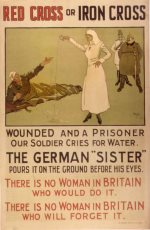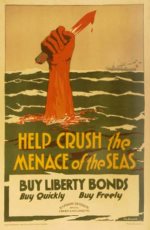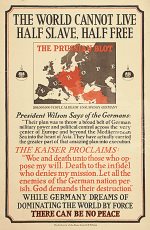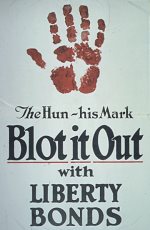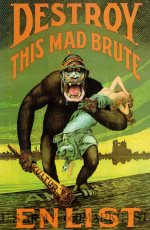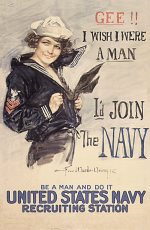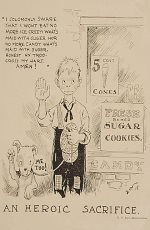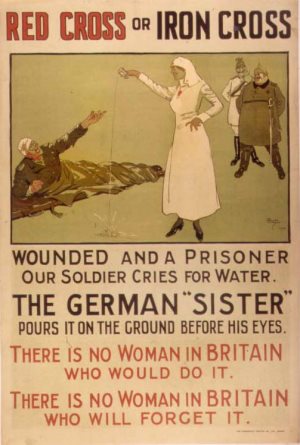
Select image for a larger version.
Propaganda consists of ideas, information, or rumors
that are spread deliberately for the purpose of
influencing people's thoughts or actions.
The goal of propagandists, or those who create and
spread propaganda, is to further their own cause or
damage an opposing cause. The information given
may be true. However, it is usually only one side of
an issue or may be presented in a distorted manner.
Propaganda can be directed at either a country's
own population or the population of the enemy,
depending on the desired effect. It can also be
delivered in many different forms. Many countries,
including the United States had special departments
within the government whose sole purpose was the
creation and spreading of propaganda.
Propaganda has been used throughout history. During World War One, both the Allies
and Central Powers used propaganda to win and maintain public support for the war
effort. One of the most frequently used methods a country used for spreading
propaganda among its own population was posters.
1. What is propaganda? (Complete Sentence)
2. What two types of population can propaganda be directed at? (Complete Sentence)
3. What has been a frequent method for the distribution of propaganda? (Complete Sentence)
4. Why was this method only used for a country's own population? (Complete Sentence)
Propagandists use several techniques to shape the way people perceive an issue. The
four main techniques are as follows. A piece of propaganda may show more than one of
the techniques, depending on the audience.
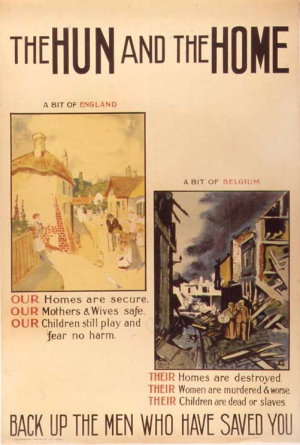
Select image for a larger version.
Half Truth
Providing only those facts that support a cause or point of view.
Definition for HUN.
5. Using proper form, write a paragraph explaining how the poster to the right is an example of the
technique of Half Truth.
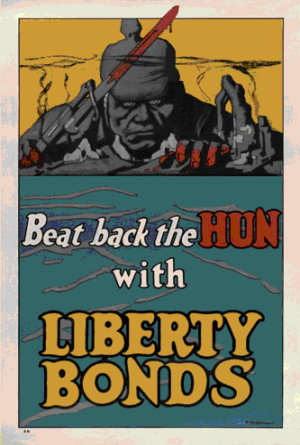
Select image for a larger version.
Name Calling
Describing one's enemies as barbarians
or less than human.
Definition for Liberty Bond.
6. Using proper form, write a paragraph explaining how the poster to the left is an example of the
technique of Name Calling.

Select image for a larger version.
Negative Imagery
Symbols that portray the enemy in the worst possible light.
7. Using proper form, write a paragraph explaining how the poster to the right is an example of the
technique of Negative Imagery.

Select image for a larger version.
Positive Imagery
Identify a cause with a famous person or noble idea.
8. Using proper form, write a paragraph explaining how the poster to the left is an example of the
technique of Positive Imagery.
The Women of America were urged to follow the militant example of Joan of Arc of
France and buy War Saving Stamps. Propaganda does not care that the British and
French are allies in this war. Few remember the embarrassing detail that it was the
English who burned Joan at the stake.
This link for May 8th in History will help you!
9. How could the poster above also be a good example of the technique of Half Truth?
(Complete Sentence)
Examine the following two early war British posters
and answer the questions that follow.
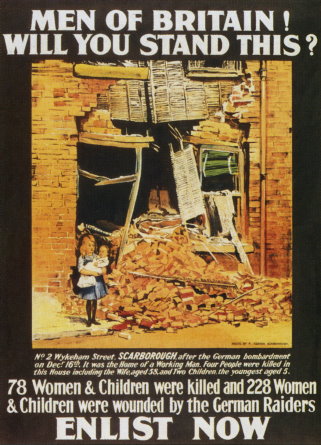
Select image for a larger version.
Identify the use of propaganda techniques.
10. What half truths do you think this poster contains? (Complete Sentence)
11. Does the poster make use of Name Calling? (Complete Sentence)
12. What details of the attack are included? Select poster for a larger image. (Complete Sentence)
13. What symbols or images are used to present the enemy in the worst possible light?
(Complete Sentence)
Analyze the emotional appeal of the propaganda.
14. Why does this poster concentrate on a single household? (Complete Sentence)
15. What emotions might this poster have stirred up in the people of Great Britain? Why?
(Complete Sentence)

Select image for larger version.
Draw Conclusions.
16. How is the emotional appeal of the poster above similar to and different from the one to the right? (Complete Sentence)
17. Who do you think paid for and distributed the poster to the right? (Complete Sentence)
18. Who was the intended audience of the poster to the right? What was the main goal? (Complete Sentence)
19. In your opinion which of the four types of propaganda would be most effective? Explain.
(Complete Sentence).
20. Write a paragraph explaining how the use of propaganda is symbolic of total war
?
21. Select three posters from below and using proper form, write a paragraph for EACH explaining what propaganda technique is being used.
Remember, more than one may be present in the same poster.
Please inform of your number choice!
First Choice
Second Choice
Third Choice



